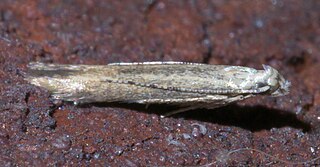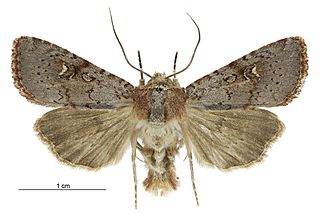Related Research Articles
Stereodmeta is a genus of moth in the family Gelechiidae. It contains the species Stereodmeta xylodeta, which is found in Brazil.

Stereomita is a genus of moths in the family Gelechiidae. It contains the species Stereomita andropogonis, which is found in most of eastern North America.

Caradrina kadenii, or Clancy's rustic, is a moth of the family Noctuidae. The species was first described by Christian Friedrich Freyer in 1836. It originates from southern and central Europe, Asia Minor and southern Russia but in the 21st century it has extended its range to the north.

Thisanotia is a monotypic moth genus of the family Crambidae described by Jacob Hübner in 1825. Its single species, Thisanotia chrysonuchella, described by Giovanni Antonio Scopoli in his 1763 Entomologia Carniolica, is found in Europe.

Athrips mouffetella is a moth of the family Gelechiidae. It is found from central and northern Europe to the Ural Mountains, Siberia and the Russian Far East. It has also been recorded from North America.
Tasmantrix tasmaniensis is a moth of the family Micropterigidae. It is known from in wet forests of western Tasmania.

Tholera cespitis, the hedge rustic, is a moth of the family Noctuidae. The species was first described by Michael Denis and Ignaz Schiffermüller in 1775. It is found through the Palearctic from Europe to the Altai Mountains of Siberia.
Choreutis irridens is a species of moth of the family Choreutidae. It is found in Mozambique.

Singularia alternaria is a moth of the family Pterophoridae. It is found in Argentina, Chile and Ecuador.

Ichneutica hartii is a moth of the family Noctuidae. This species is endemic to New Zealand and can be found only in the North Island. I. hartii is similar in appearance to Ichneutica agrorastis but can be distinguished as it tends to be smaller in size and have a more purplish shade to its fore wings. I. hartii tends to be found inhabiting lowland native forest or forests found in the hilly ranges of the North Island. It is attracted to light and the adults of this moth are on the wing between January and March. Much of its life history is currently unknown as are the larvae host species.

Eana osseana, common name dotted shade, is a moth of the family Tortricidae.
Russograptis solaris is a species of moth of the family Tortricidae. It is found in Nigeria.
Depressaria artemisiella is a moth in the family Depressariidae. It was described by James Halliday McDunnough in 1927. It is found in North America, where it has been recorded from British Columbia and Utah.

Kessleria alpmaritimae is a moth of the family Yponomeutidae. It is found only in the Marguareis Massif, in the French Alpes Maritimes. The habitat consists of rocky areas on calcareous soil.
Eremicamura is a moth genus in the family Autostichidae. It contains the species Eremicamura mercuriata, which is found in the Russian Far East (Amur).
Paraspastis circographa is a moth of the family Depressariidae and the only species in the genus Paraspastis. It is found in Guyana.
Synersaga atriptera is a moth in the family Lecithoceridae. It is found in China (Guangdong).

Udea albostriata is a moth in the family Crambidae. It was first described by Zhang and Li in 2016. It is found in Hebei, China.

Ichneutica averilla is a moth of the family Noctuidae. It is endemic to New Zealand. This species is found in the North Island at Mount Taranaki but is widespread throughout the South Island and Stewart Island. It prefers mountainous habitat but can be found down to sea level in the southern parts of the South Island. Adults of the species are on the wing between November and March. Larvae likely exist on a variety of herbaceous plants but have been recorded as feeding on species within the genus Plantago. This species is sometimes confused with I. mutas but can be distinguished from the latter on the basis of forewing colour as well as the absence of or an indistinct antemedian forewing line.

Meterana badia is a species of moth in the family Noctuidae. This species is endemic to New Zealand.
References
- ↑ Menestomorpha at funet.fi.
- ↑ mothphotographersgroup
- ↑ Proc. U.S. Nat. Mus. 116 (3495) : 48
 This article incorporates text from this source, which is in the public domain .
This article incorporates text from this source, which is in the public domain .